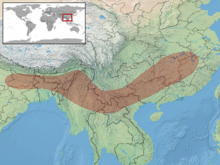Protobothrops jerdonii, also known commonly as Jerdon's pit viper,[3][4] the yellow-speckled pit viper, and the oriental pit viper, is a species of venomous snake in the subfamily Crotalinae of the family Viperidae. The species is native to India, Nepal, Myanmar, China, and Vietnam. Three subspecies are recognized, including the nominate subspecies described here.[3][5]
| Protobothrops jerdonii | |
|---|---|

| |
| at the San Diego Zoo | |
| Scientific classification | |
| Domain: | Eukaryota |
| Kingdom: | Animalia |
| Phylum: | Chordata |
| Class: | Reptilia |
| Order: | Squamata |
| Suborder: | Serpentes |
| Family: | Viperidae |
| Genus: | Protobothrops |
| Species: | P. jerdonii
|
| Binomial name | |
| Protobothrops jerdonii (Günther, 1875)
| |

| |
| Synonyms[3] | |
| |

Etymology
editThe specific name, jerdonii, is in honor of British herpetologist Thomas C. Jerdon, who collected the type series.[6]
The subspecific name, bourreti, is in honour of French herpetologist René Léon Bourret.[6]
Description
editMales of P. jerdonii grow to a maximum total length of 835 mm (32.9 in), which includes a tail length of 140 mm (5.5 in); females grow to 990 mm (39 in), with a tail length of 160 mm (6.3 in).[7]
Scalation: dorsal scales in 21 longitudinal rows at midbody (rarely 23); snout length a little more than twice diameter of eye; head above, except for large internasals and supraoculars, covered by small, unequal, smooth scales that are feebly imbricate or juxtaposed; first labial completely separated from nasal scales by a suture; internasals separated by 1–2 small scales; 6–9 small scales in line between supraoculars; 7–8 upper labials, third and fourth beneath eye, in contact with subocular or separated by at most a single series of small scales; ventrals: males 164–188, females 167–193; subcaudals: males 50–78, females 44–76.[7]
Geographic range
editP. jerdonii is found in northeastern India, Nepal, through northern Burma to southwestern China and Vietnam.[3] The type locality given by Günther is "Khassya" (=Khasi Hills, India).[2]
Habitat
editThe preferred natural habitats of P. jerdonii are forest, shrubland, and grassland, at altitudes of 1,400–2,300 m (4,600–7,500 ft).[1]
Diet
editAdults of P. jerdonii prey predominately upon rats, while juveniles prey upon frogs of the families Ranidae and Rhacophoridae.[1]
Reproduction
editThe mode of reproduction of P. jerdonii has been referred to as viviparous[1] and as ovoviviparous.[3] Litter size is five to eight newborns.[1]
Subspecies
edit| Subspecies[3][5] | Taxon author[3][5] | Common name[8] | Geographic range[8] |
|---|---|---|---|
| P. j. bourreti | (Klemmer, 1963) | Bourret's pitviper | Northwestern Vietnam (in the provinces of Lào Cai and Lai Châu, and possibly also in adjacent China (Yunnan). |
| P. j. jerdonii | (Günther, 1875) | Jerdon's pitviper | Southwestern China (in the provinces of southern Xizang (Tibet), western Sichuan and Yunnan), northeastern India, Bangladesh, Burma (Chin and Kachin state), and northeastern Nepal. |
| P. j. xanthomelas | (Günther, 1889) | red spotted pitviper | Central and southern China (in the provinces of Henan, Shaanxi, Gansu, Sichuan, Guizhou, Hubei and Guangxi) and northeastern India(Arunachal Pradesh).[9] |
Nota bene: A trinomial authority in parentheses indicates that the subspecies was originally described in a genus other than Protobothrops.
References
edit- ^ a b c d e Wogan G, Das I, Jiang J, Bain R (2012). "Protobothrops jerdonii ". The IUCN Red List of Threatened Species 2012: https://dx.doi.org/10.2305/IUCN.UK.2012-1.RLTS.T178419A1533609.en. Accessed on 25 June 2024.
- ^ a b McDiarmid RW, Campbell JA, Touré TA (1999). Snake Species of the World: A Taxonomic and Geographic Reference, Volume 1. Washington, District of Columbia: Herpetologists' League. 511 pp. ISBN 1-893777-00-6 (series). ISBN 1-893777-01-4 (volume).
- ^ a b c d e f g Protobothrops jerdonii at the Reptarium.cz Reptile Database. Accessed 30 October 2018.
- ^ Brown, John Haynes (1973). Toxicology and Pharmacology of Venoms from Poisonous Snakes. Springfield, Illinois: Charles C. Thomas. 184 pp. LCCCN 73–229. ISBN 0-398-02808-7.
- ^ a b c "Trimeresurus jerdonii". Integrated Taxonomic Information System. Retrieved 25 May 2007.
- ^ a b Beolens B, Watkins M, Grayson M (2011). The Eponym Dictionary of Reptiles. Baltimore: Johns Hopkins University Press. xiii + 296 pp. ISBN 978-1-4214-0135-5. (Protobothrops jerdonii, p. 134; P. j. bourreti, p. 35).
- ^ a b Leviton AE, Wogan GO, Koo MS, Zug GR, Lucas RS, Vindum JV (2003). "The dangerously venomous snakes of Myanmar. Illustrated checklist with keys" (PDF). Proceedings of the California Academy of Sciences. 54 (24): 407–462.
- ^ a b Gumprecht A, Tillack F, Orlov NL, Captain A, Ryabov S (2004). Asian Pitvipers. First Edition. Berlin: GeitjeBooks. 368 pp. ISBN 3-937975-00-4.
- ^ Zambre, Amod; Sheth, Chintan; Dalvi, Shashank; Kulkarni, Nirmal (2009). "First record of Protobothrops jerdonii xanthomelas (Günther, 1889) from Eaglenest Wildlife Sanctuary, India". Journal of the Bombay Natural History Society 106 (2): 325-327.
Further reading
edit- Boulenger GA (1890). The Fauna of British India, Including Ceylon and Burma. Reptilia and Batrachia. London: Secretary of State for India in Council. (Taylor and Francis, Printers). xviii + 541 pp. (Trimeresurus jerdonii, pp. 427–428).
- Boulenger GA (1896). Catalogue of the Snakes in the British Museum (Natural History). Volume III., Containing the ... Viperidæ. London: Trustees of the British Museum (Natural History). (Taylor and Francis, printers). xiv + 727 pp. + Plates I–XXV. (Lachesis jerdonii, pp. 551–552).
- Das I (2002). A Photographic Guide to Snakes and other Reptiles of India. Sanibel Island, Florida: Ralph Curtis Books. 144 pp. ISBN 0-88359-056-5. (Protobothrops jerdonii, p. 63).
- Günther A (1875). "Second Report on Collections of Indian Reptiles obtained by the British Museum". Proceedings of the Zoological Society of London 1875: 224–234. (Trimeresurus jerdonii, new species, pp. 233–234 + Plate XXXIV).
- Smith MA (1943). The Fauna of British India, Ceylon and Burma, Including the Whole of the Indo-Chinese Sub-region. Reptilia and Amphibia. Vol. III.—Serpentes. London: Secretary of State for India. (Taylor and Francis, printers). xii + 583 pp. (Trimeresurus jerdoni, pp. 510–511, Figure 162).
